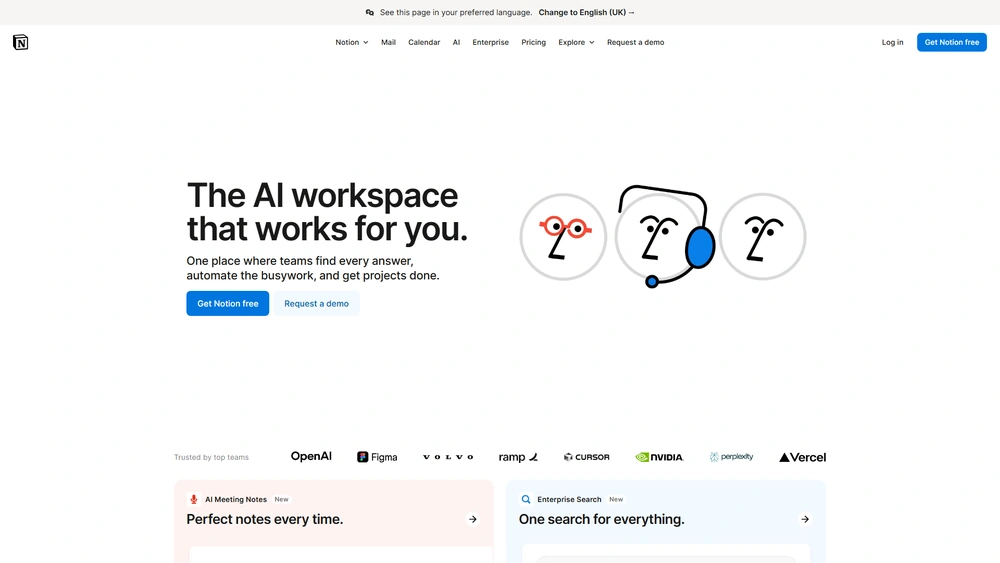Notion Overview & 2025 Industry Position
Notion has rapidly ascended from a niche productivity tool into a fully-fledged workspace platform that caters to teams, enterprises, educators, and creators alike. In 2025, it stands as a central hub for knowledge management, project planning, and everyday operational work. With its modular block-based design, robust AI features, and seamless integrations, Notion is successfully blurring the lines between documentation, task management, and collaboration—something few competitors have managed to achieve at scale.
From Launch to 2025: Notion’s Journey
Founded in 2013 by Ivan Zhao and Simon Last, Notion launched publicly in 2016 as a simple note-taking app with a unique block-based interface. Over time, it evolved into a multifaceted productivity suite. Major milestones include:
- 2018: Version 2.0 brings databases and team features.
- 2020: $50M funding round led by Index Ventures; valuation hits $2B.
- 2021: Workspace capabilities introduced; user base surges post-pandemic.
- 2022: Acquisition of Cron and Flowdash strengthens scheduling and workflow automation.
- 2023: Notion AI launches—an embedded AI assistant powered by LLMs.
- 2025: Cross-suite integration with popular CRMs and ERPs solidifies enterprise appeal.
The 2025 strategy? A unified knowledge + task layer powered by AI to remove context switching and duplicative workflows across apps.

Notion Key Features
Notion’s strength lies in its modularity. Users build pages from blocks—text, databases, toggles, embeds, and now AI. In 2025, the standout features include:
- Docs & Wikis: Collaborative editing, slash commands, and templates.
- Project Management: Kanban boards, calendars, Gantt-style timelines.
- Notion AI: Contextual writing assistance, summarization, auto-tagging, and workflow generation.
- Databases: Custom properties, relation/rollups, views (list, gallery, table).
- Templates: Community-driven designs for startups, students, PMs, and more.
Workflow & UX
Using Notion feels intuitive once users get past the initial flexibility shock. Whether you start with a blank page or a template, everything is drag-and-drop reconfigurable. The updated 2025 interface includes:
- Global Search 3.0: AI-powered search that understands intent and relationships.
- Sidebar redesign: Smart pinning, recent/favorites logic, and tabbed workspaces.
- Real-time collaboration: Inline comments, mentions, and page history.
Pro Tip: Use Notion’s templates as springboards—then customize blocks to match your team’s terminology and workflows.
Notion Pricing Analysis & Value Metrics
As of July 2025, Notion offers four pricing tiers:
| Plan | Price (Monthly) | Key Features |
|---|---|---|
| Free | $0 | Unlimited pages, basic blocks, up to 10 guests |
| Plus | $10/user | Unlimited guests, version history, integrations |
| Business | $18/user | Advanced permissions, private teams, SSO, AI add-on |
| Enterprise | Custom | Audit logs, SCIM, advanced security & compliance |
Assessment: Competitive at all tiers. Bonus value stems from native AI and its replacement of multiple separate tools (docs, PM, calendar, wiki).
Competitive Landscape
- ClickUp: Better for granular task control; lacks Notion AI depth.
- Confluence: Enterprise-oriented; less visual and fluid.
- Airtable: Database-first; excellent for structured data, weaker docs.
- Obsidian: Local markdown and knowledge graph; lacks collaboration tools.
Verdict: Notion wins in all-in-one flexibility and UX design; may fall short for highly structured data ops work.
Use Cases by Industry
From startups to universities, Notion adapts to diverse workflows. Top use cases include:
- Startups: Team wikis, OKRs, sprint reviews, CRM builds
- Agencies: Client portals, invoicing dashboards, campaign trackers
- Educators/Students: Class notes, project timelines, resource libraries
- Freelancers: Personal productivity hub, portfolio, invoice tracker
Notion Integrations
Notion boasts a growing list of integrations to extend its workspace. Key 2025 entries:
- Slack: Sync status, link pages inside chats
- Zapier & Make: Automation workflows
- Figma, Miro: Embedded design canvases
- GitHub: Dev workflow documentation & issue tracking
- QuickBooks/Xero: Accounting dashboards via third-party syncs
Pros & Cons Summary
- Pros: Extremely flexible; built-in AI; great UI; all-in-one functionality; growing templates and tutorials.
- Cons: Steep initial learning curve; potentially overwhelming without structure; power features gated behind paid tiers.
Final Thoughts: Best Fit & Trade-Offs
Notion is a Swiss army knife for digital workspaces. It’s ideal for users willing to invest time into setup in exchange for total customization. Startups, independent professionals, and even enterprise teams seeking project transparency and knowledge centralization will benefit. Those needing rigid data models, instant out-of-the-box workflows, or offline priority may want to evaluate specialized tools instead.
Notion FAQ
Yes, Notion offers a fully functional Free plan with essential features for individuals and small collaboration groups.
Notion AI is an embedded assistant for writing, summarizing, organizing, and automating workflows. It’s included with Business and Enterprise plans or as an add-on.
Notion supports limited offline access via desktop and mobile apps, but full sync happens only with internet connection.
You can embed live previews or links of Google Docs and Sheets inside Notion, but real-time two-way sync requires third-party tools.
Yes, Notion offers SOC 2 Type II compliance, SSO, permission controls, and audit logs—especially in its Business and Enterprise plans.